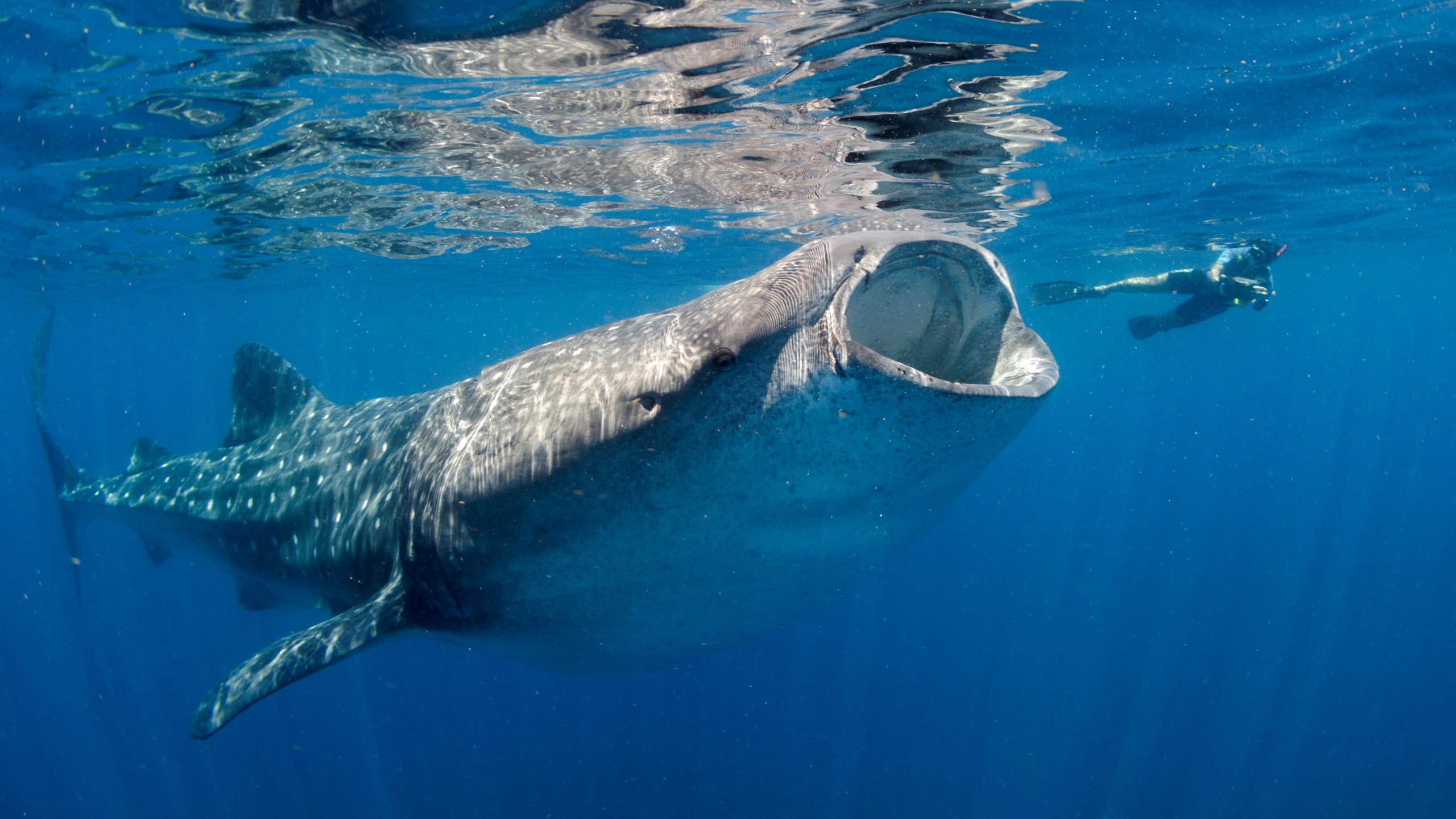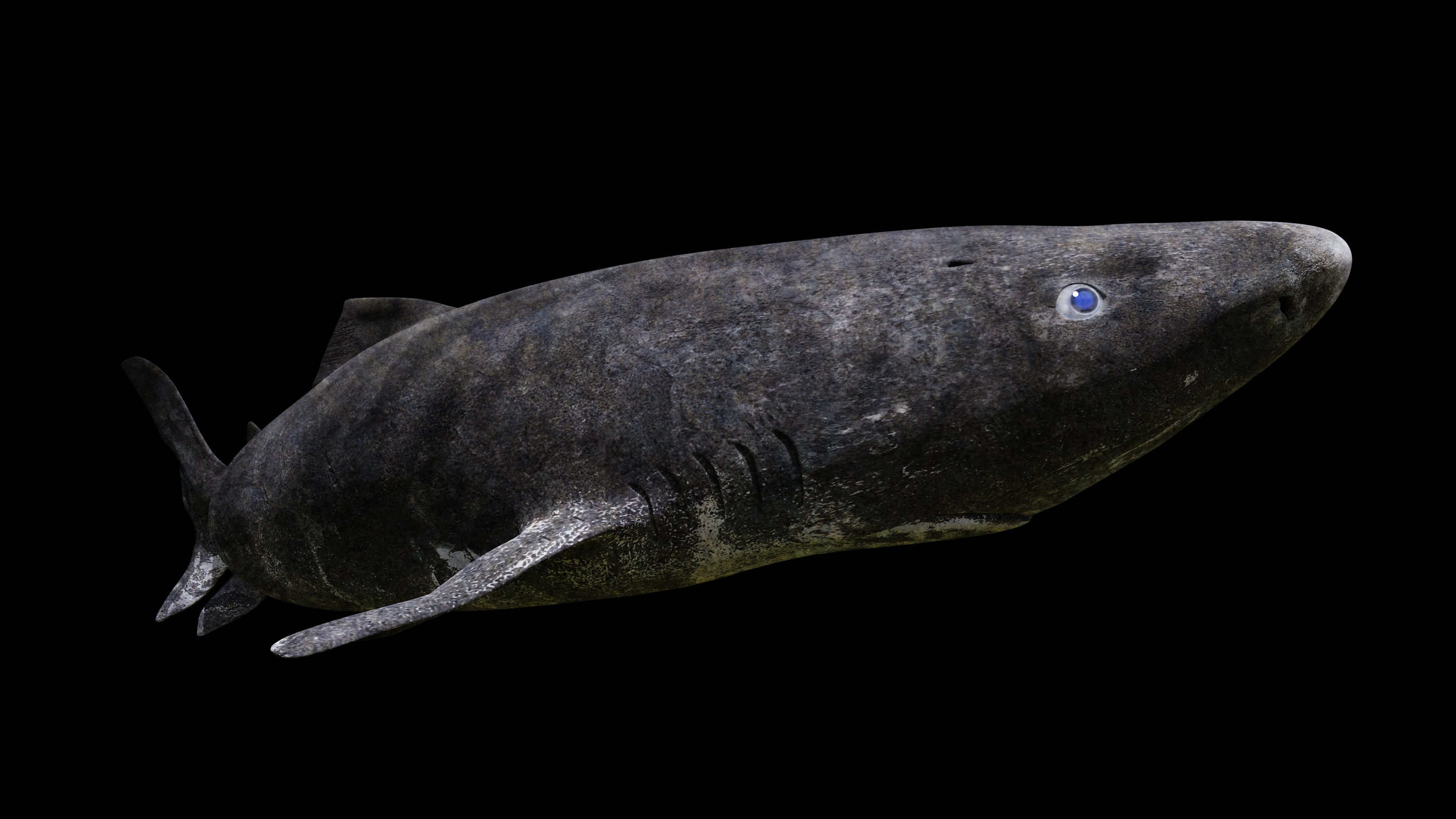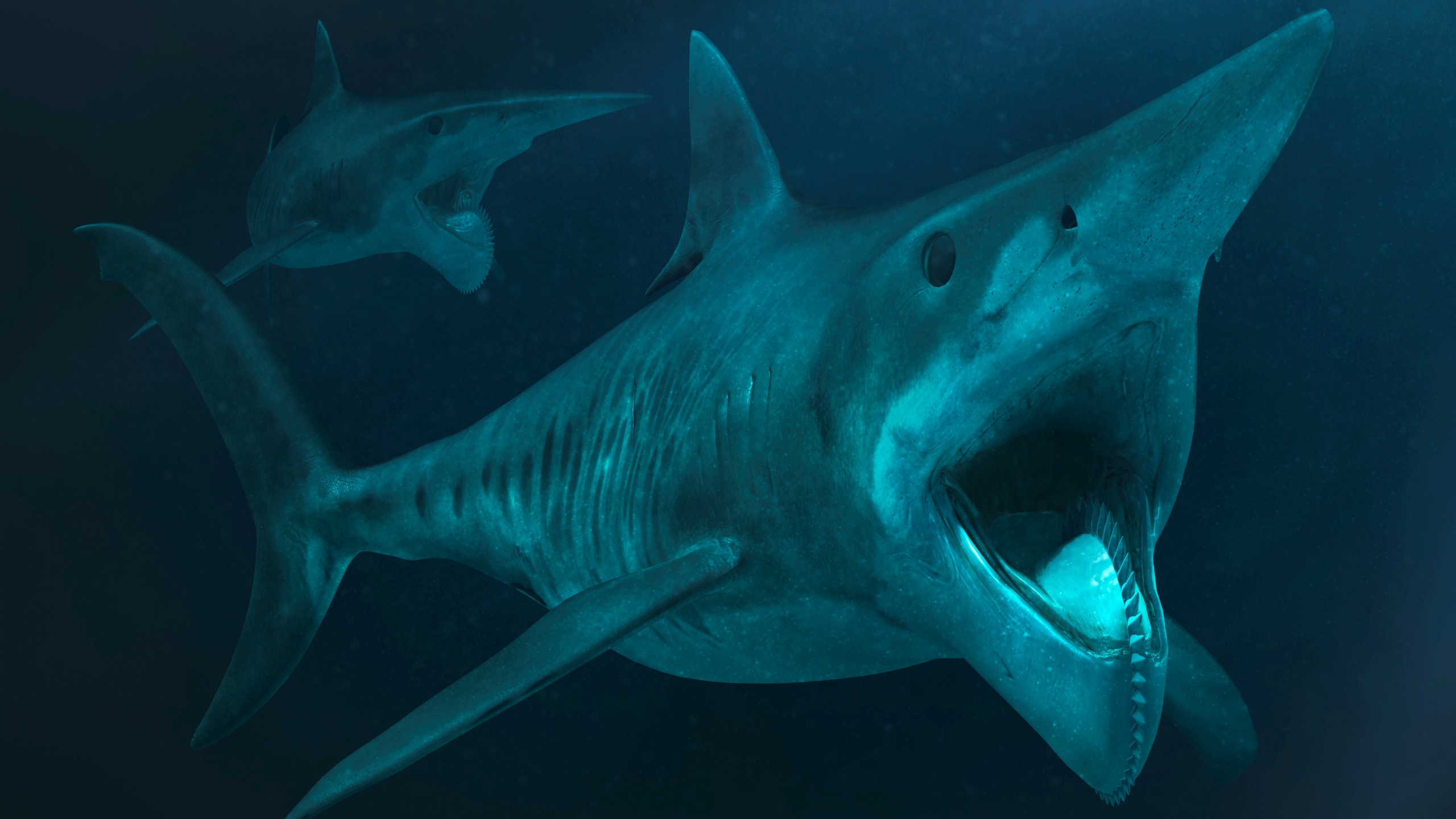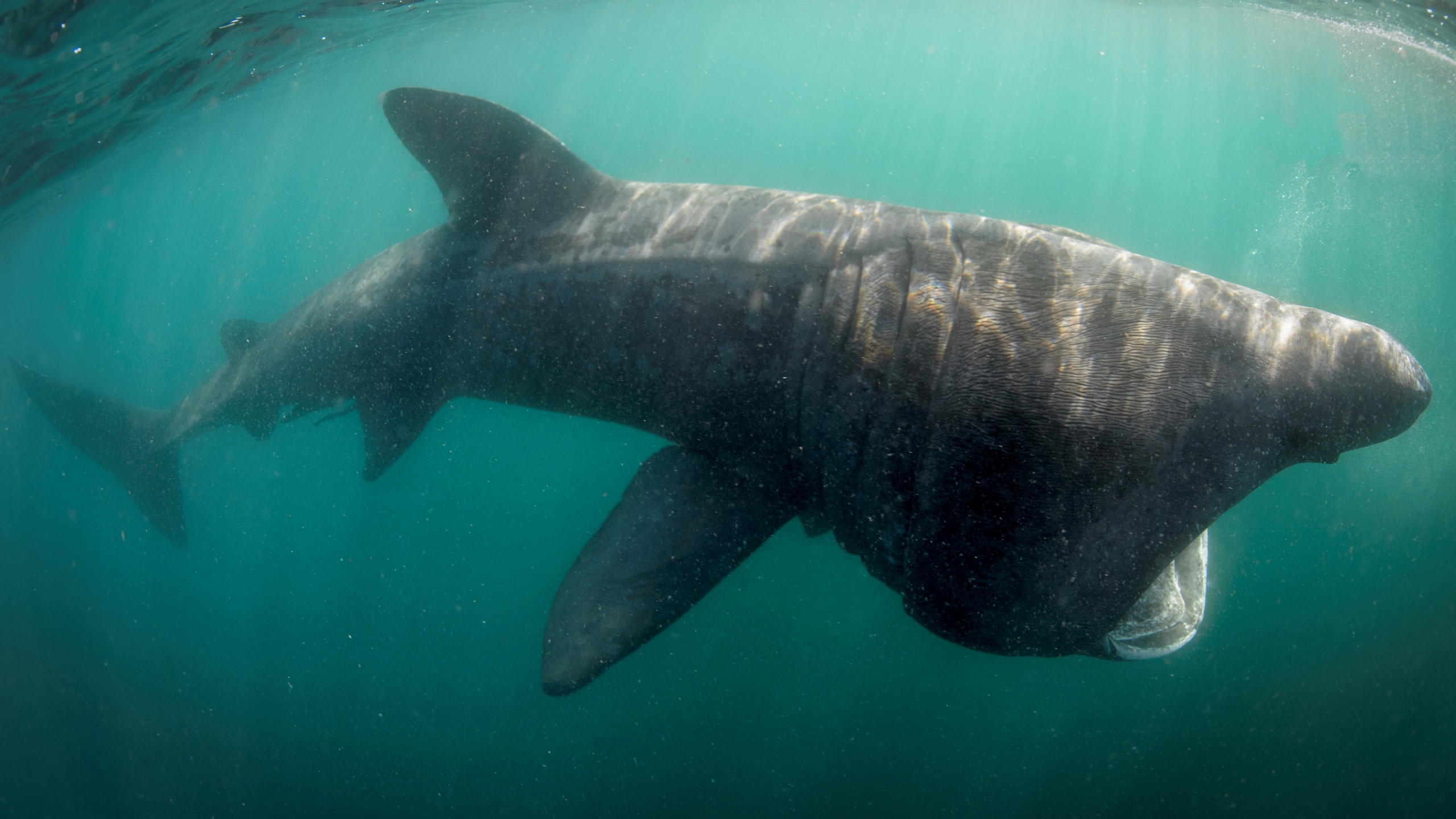Biggest sharks in the world
Some of the biggest sharks to have ever lived are lurking in our oceans today.

Sharks are a diverse group of fish that have been prowling our oceans for hundreds of millions of years. The group includes several large, food chain-topping predators from the extinct Helicoprion, which had a jaw like a circular saw, to modern-day great white sharks that accelerate through water like a bullet as they hunt down their prey.
Giant sharks have evolved and gone extinct throughout Earth's history and plenty of behemoths still lurk in the ocean today 一 though not all are ferocious predators. Here are eight of the biggest sharks from past and present.
8. Megamouth shark

Megamouth sharks (Megachasma pelagios) are filter feeders and eat vast quantities of tiny shrimplike crustaceans and plankton, rather than hunting larger prey. The sharks feed by taking big gulps of seawater and then pushing the water out through their gills, leaving their mouth full of tasty little critters. Megamouth sharks can grow to about 16 feet (5 meters) long and weigh 1,650 pounds (750 kilograms), according to the University of Michigan's Animal Diversity Web (ADW).
The species was first discovered off the coast of Hawaii in 1976 when a megamouth shark was struck and became entangled in the anchor of a Navy ship, Live Science previously reported. Megamouth sharks spend their days deep in the ocean but ascend to surface waters at night as they follow their food source. They live in all major oceans around the world but their exact distribution remains poorly understood by scientists, according to the International Union for Conservation of Nature (IUCN).
7. Thresher shark
One look at a common thresher shark (Alopias vulpinus) and it's easy to see where the bulk of its size comes from — their long, sickle-shaped tails make up half their total body length, according to the National Oceanic and Atmospheric Administration (NOAA). Thresher sharks swipe their enormous tails like a whip to stun fish, smacking them directly and with the powerful waves generated by the swipes, making their prey easier to catch, Live Science previously reported.
The sharks often grow to 20 feet (6.1 m) long. The largest thresher shark ever recorded was 24.9 feet (7.6 m) long, and the heaviest weighed more than 750 pounds (340 kg), according to the Florida Museum of Natural History. Thresher sharks live in tropical and cold sea waters worldwide and mostly eat small, schooling fish such as herring.
Related: Whodunit solved when 'sword' is found embedded in thresher shark
Sign up for the Live Science daily newsletter now
Get the world’s most fascinating discoveries delivered straight to your inbox.
6. Greenland shark

Greenland sharks (Somniosus microcephalus) are peculiar animals that inhabit deep, cold waters in the Arctic and North Atlantic oceans. Ocean parasites often attach themselves to the eyes of Greenland sharks, which can render them partially blind. But that doesn't seem to bother these sharks much, as they use their other senses to catch prey, according to ADW. Greenland sharks eat fish and marine mammals such as seals. They grow slowly but can reach lengths of 24 feet (7.3 m) and weigh up to 2,645 pounds (1,200 kg), according to the St. Lawrence Shark Observatory in Canada.
Related: No, scientists haven't found a 512-year-old Greenland shark
A 2016 study of Greenland shark eye tissue published in the journal Science estimated that these sharks don't even reach sexual maturity until they are about 156 years old, Live Science previously reported. The study also suggested that the maximum lifespan of a Greenland shark is at least 272 years, with the oldest shark in the study estimated to have been about 392 years old.
"It's important to keep in mind there's some uncertainty with this estimate," Julius Nielsen, co-author of the 2016 paper previously told Live Science. "But even the lowest part of the age range — at least 272 years — still makes Greenland sharks the longest-living vertebrate known to science."
5. Great white shark

Great white sharks (Carcharodon carcharias) are perhaps the best-known predators in the ocean and the largest living sharks that don't filter feed. The biggest great white sharks are estimated to grow to 20 feet (6 m) long but there are unconfirmed reports of these sharks reaching lengths of 23 feet (7 m), according to the Florida Museum of Natural History. They can also weigh up to 7,000 pounds (more than 3,000 kg), according to the World Wildlife Fund (WWF).
As juveniles, great white sharks spend most of their time hunting fish and other small prey on and near the seafloor, Live Science previously reported. When they grow up, the sharks hunt down marine mammals such as sea lions and dolphins. Great white sharks have a wide geographic range but are most common in temperate waters, such as off the west coast of the U.S. in the Pacific Ocean, according to the IUCN.
4. Helicoprion

There are a handful of extinct sharks that would comfortably meet and surpass the size of modern great white sharks and Greenland sharks, but the Helicoprion is perhaps the most bizarre example. This ancient ratfish relative is nicknamed the "buzz saw shark" as it had a whorl jaw with a spiral set of teeth. Fossilized Helicoprion jaws, which resemble spiky ammonites, indicate these sharks may have grown up to 25 feet (7.7 m) long, making them the largest predator on Earth when they lived nearly 270 million years ago, Live Science previously reported.
Related: Toothy spiral jaw gave ancient sea predator an edge
3. Basking shark

Great white sharks may be the largest predatory shark alive today but they seem almost quaint next to the biggest filter-feeding sharks. Although basking sharks (Cetorhinus maximus) only eat plankton, they can reach up to 40 feet (12.2 m) in length and weigh more than 5 tons (4.5 metric tons), according to the Florida Museum of Natural History. These behemoths are most commonly found in the Atlantic and Pacific Oceans, according to the IUCN.
Basking sharks are often regarded as slow, gentle giants but they are capable of rocketing out of the water at speeds of 11 mph (18 km/h) and jumping 4 feet (1.2 m) in the air to breach, Live Science previously reported. This breaching behavior may be used to communicate with other basking sharks or to rid themselves of parasites.
2. Whale shark

Whale sharks (Rhincodon typus) are the biggest filter-feeding sharks and the biggest fish in the world. They usually grow to between 18 and 33 feet (5 to 10 m) long and weigh around 21 tons (19 metric tons). However, the largest whale shark ever recorded was a whopping 66 feet (20 m) long and weighed 46 tons (42 metric tons), according to the Zoological Society of London. Whale sharks live in tropical and warm temperate oceans around the world, except for the Mediterranean Sea.
Whale sharks are categorized as an endangered species by the IUCN and are threatened with extinction due to fishing, boat strikes and other human activity.
1. Megalodon

The undisputed king of predatory sharks is the megalodon (Carcharocles megalodon). Members of this extinct species are the largest sharks to have ever lived and the biggest fish known to science. The exact size of megalodon is debated within the scientific community but they may have been up to about 60 feet (18 m) long based on teeth fossils, and perhaps even 80 feet (24 m) long. That's three to four times the length of the biggest great white sharks. They may also have weighed up to 50 tons (45.4 metric tons), according to the Smithsonian National Museum of Natural History.
Related: Megalodon shark mamas had human-size cannibal babies
Most megalodon fossils are dated to between the middle Miocene epoch and the Pliocene epoch (15.9 million to 2.6 million years ago) and there is no record of them existing after this period. Megalodon have been resurrected on the big screen, such as in the 2018 science fiction thriller "The Meg," but the real megalodons are long gone.

Patrick Pester is the trending news writer at Live Science. His work has appeared on other science websites, such as BBC Science Focus and Scientific American. Patrick retrained as a journalist after spending his early career working in zoos and wildlife conservation. He was awarded the Master's Excellence Scholarship to study at Cardiff University where he completed a master's degree in international journalism. He also has a second master's degree in biodiversity, evolution and conservation in action from Middlesex University London. When he isn't writing news, Patrick investigates the sale of human remains.









